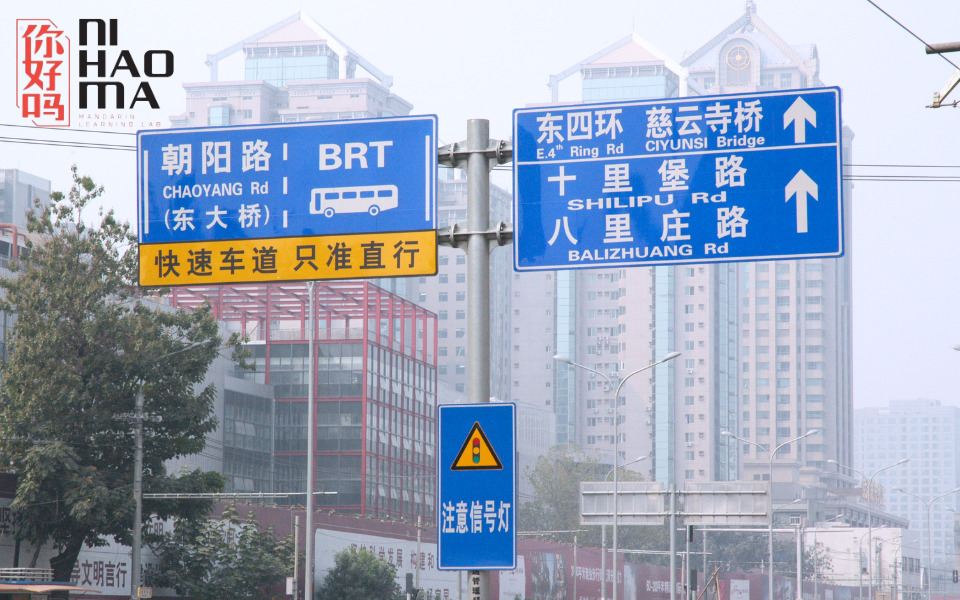Have you ever found yourself in a situation where you didn’t know how to ask for directions in Chinese? Or struggled to describe a location to someone? Chances are, you’re missing some essential vocabulary for directions in Chinese — a set of words that may seem simple but are incredibly important. In this article, Ni Hao Ma will explore the basic vocabulary related to directions in Chinese and show you how to use them through practical sentence patterns.
Vocabulary for Directions in Chinese
Ever wondered how to say north, south, east, and west in Chinese? Or how to describe “in front of,” “behind,” “to the left,” and “to the right”? When communicating in Chinese, being able to use direction-related vocabulary accurately is crucial. These words help you ask for directions, describe the position of objects, and understand spatial instructions given by others.

Here is a useful list of vocabulary compiled by Ni Hao Ma to help you express directions in Chinese:
| No | Chinese | Pinyin | Meaning |
|---|---|---|---|
| 1 | 东 | dōng | East |
| 2 | 西 | xī | West |
| 3 | 南 | nán | South |
| 4 | 北 | běi | North |
| 5 | 东北 | dōngběi | Northeast |
| 6 | 东南 | dōngnán | Southeast |
| 7 | 西北 | xīběi | Northwest |
| 8 | 西南 | xīnán | Southwest |
| 9 | 左边 | zuǒbiān | Left side |
| 10 | 右边 | yòubiān | Right side |
| 11 | 前面 | qiánmiàn | Front |
| 12 | 后面 | hòumiàn | Back |
| 13 | 上 | shàng | Above |
| 14 | 下 | xià | Below |
| 15 | 中间 | zhōngjiān | Middle |
| 16 | 旁边 | pángbiān | Beside |
| 17 | 对面 | duìmiàn | Opposite |
| 18 | 里面 | lǐmiàn | Inside |
| 19 | 外面 | wàimiàn | Outside |
| 20 | 道路 | dàolù | Road |
| 21 | 往 | wǎng | Toward |
| 22 | 朝 | cháo | Facing toward |
| 23 | 拐 | guǎi | Turn |
| 24 | 直走 | zhízǒu | Go straight |
| 25 | 前 | qián | Front |
| 26 | 后 | hòu | Back |
| 27 | 边缘 | biānyuán | Edge, border |
| 28 | 偏 | piān | Slightly toward |
| 29 | 远 | yuǎn | Far |
| 30 | 近 | jìn | Near |
Common Sentence Patterns for Directions in Chinese
When learning Chinese, one of the most practical and essential skills is knowing how to give and understand directions — especially when you’re traveling, asking for help, or describing a location. To help you use the vocabulary above more effectively, let’s look at some commonly used structures:
Describing the Position of a Place
A 在 (zài) + B 的 (de) + [direction word]
This structure means “A is to the [direction] of B.” It’s a basic and commonly used sentence pattern in Chinese to indicate the spatial relationship between two objects or places. It allows for more accurate descriptions than simply saying “it’s somewhere over there.”
Examples:
学校在我家的北边。
Xuéxiào zài wǒ jiā de běibiān.
→ The school is to the north of my house.
商店在图书馆的右边。
Shāngdiàn zài túshūguǎn de yòubiān.
→ The shop is to the right of the library.
书在桌子的上面。
Shū zài zhuōzi de shàngmiàn.
→ The book is on top of the table.
Learn more about locations in Chinese in the article: 1000 Basic Chinese Vocabulary Words for Beginners

Giving Directions Using Movement
往 (wǎng) + [direction] + 走 (zǒu)
This phrase is a very common and direct way to give directions in Chinese. It’s used when instructing someone to go toward a specific direction or describing the direction someone is heading.
Examples:
往东走五分钟就到了。
Wǎng dōng zǒu wǔ fēnzhōng jiù dàole.
→ Walk east for five minutes and you’ll arrive.
你一直往前走。
Nǐ yìzhí wǎng qián zǒu.
→ Keep going straight ahead.
请往左走,那是出口。
Qǐng wǎng zuǒ zǒu, nà shì chūkǒu.
→ Please go left; that’s the exit.
Giving Directions Involving a Turn
向/往 + [direction] + 转 (zhuǎn)
This structure is used to instruct someone to turn in a specific direction. It’s very useful when giving step-by-step directions, such as turning at an intersection or changing direction.
Examples:
你走到第一个路口,往左转,就能看到图书馆了。
Nǐ zǒu dào dì yī gè lùkǒu, wǎng zuǒ zhuǎn, jiù néng kàndào túshūguǎn le.
→ Walk to the first intersection, turn left, and you’ll see the library.
你往左转,走一百米就到了。
Nǐ wǎng zuǒ zhuǎn, zǒu yì bǎi mǐ jiù dàole.
→ Turn left and walk about 100 meters to arrive.

How to Ask for Directions in Chinese
请问,……怎么走?
(Qǐngwèn, … zěnme zǒu?)
The phrase “请问,……怎么走?” means “Excuse me, how do I get to [location]?” This is one of the most common and polite ways to ask for directions in Chinese when you don’t know how to get somewhere and need help.
Examples:
请问,火车站怎么走?
Qǐngwèn, huǒchēzhàn zěnme zǒu?
→ Excuse me, how do I get to the train station?
请问,去银行怎么走?
Qǐngwèn, qù yínháng zěnme zǒu?
→ Excuse me, how do I get to the bank?
How to Talk About Distance (Far/Near) in Chinese
A + 离 (lí) + B + 远/近 (yuǎn/jìn)
This structure is one of the most fundamental and frequently used ways in Chinese to describe relative distance between two places or objects. It tells you whether something is near or far from another location.
Examples:
我家离学校很近。
Wǒ jiā lí xuéxiào hěn jìn.
→ My home is very close to the school.
这里离火车站很近。
Zhèlǐ lí huǒchēzhàn hěn jìn.
→ This place is very close to the train station.
这家饭店离公司挺远的。
Zhè jiā fàndiàn lí gōngsī tǐng yuǎn de.
→ This restaurant is quite far from the company.

Sample Dialogues Using Direction Vocabulary in Chinese
When learning Chinese, it’s essential and practical to master both the vocabulary and sentence structures related to directions. Below are real-life conversation examples that demonstrate how to use directions in Chinese effectively.
Dialogue 1
A: 请问,最近的地铁站怎么走?
(Qǐngwèn, zuìjìn de dìtiězhàn zěnme zǒu?)
→ Excuse me, how do I get to the nearest subway station?
B: 哦,地铁站啊。你一直往前走,走到第二个红绿灯。
(Ó, dìtiězhàn a. Nǐ yīzhí wǎng qián zǒu, zǒu dào dì èr ge hónglǜdēng.)
→ Oh, the subway station. Just go straight ahead until you reach the second traffic light.
A: 第二个红绿灯?
(Dì èr ge hónglǜdēng?)
→ The second traffic light?
B: 对,到了红绿灯,你往右拐。地铁站就在你右手边。
(Duì, dào le hónglǜdēng, nǐ wǎng yòu guǎi. Dìtiězhàn jiù zài nǐ yòushǒubiān.)
→ Yes, when you reach the light, turn right. The subway station will be on your right-hand side.
A: 好的,谢谢您!
(Hǎo de, xièxie nín!)
→ Okay, thank you so much!
Learn more: How to Say Thank You in Chinese and How to Respond Politely

Dialogue 2
A: 听说学校附近开了一家新咖啡馆,你知道在哪儿吗?
(Tīngshuō xuéxiào fùjìn kāi le yī jiā xīn kāfēiguǎn, nǐ zhīdào zài nǎr ma?)
→ I heard there’s a new café near the school. Do you know where it is?
B: 我知道。它离学校不太远,就在学校大门往左走,大概五分钟。
(Wǒ zhīdào. Tā lí xuéxiào bú tài yuǎn, jiù zài xuéxiào dàmén wǎng zuǒ zǒu, dàgài wǔ fēnzhōng.)
→ I know. It’s not too far from the school—just turn left from the main entrance and walk about five minutes.
A: 哦,是吗?那它旁边有什么标志性建筑吗?
(Ó, shì ma? Nà tā pángbiān yǒu shénme biāozhìxìng jiànzhù ma?)
→ Oh really? Are there any landmarks near it?
B: 有。咖啡馆在一家很大的书店对面。你看到书店就看到咖啡馆了。
(Yǒu. Kāfēiguǎn zài yī jiā hěn dà de shūdiàn duìmiàn. Nǐ kàndào shūdiàn jiù kàndào kāfēiguǎn le.)
→ Yes. The café is right across from a large bookstore. If you see the bookstore, you’ll see the café.
A: 太好了!谢谢你!
(Tài hǎo le! Xièxie nǐ!)
→ That’s great! Thank you!
Conclusion
We hope this article by Ni Hao Ma has provided you with a clear and practical understanding of the vocabulary and sentence patterns used to give and ask for directions in Chinese. Mastering these will not only make you more confident when navigating or giving location-based instructions, but also enrich your everyday conversation skills. Don’t hesitate to apply these in real-life scenarios — it’s the best way to turn them into natural, reflexive expressions!



